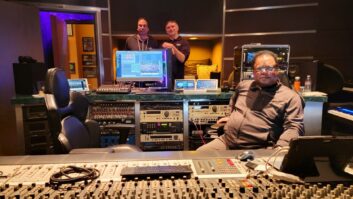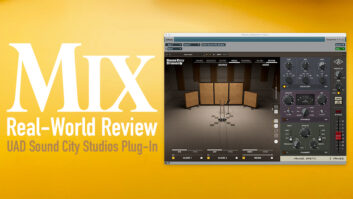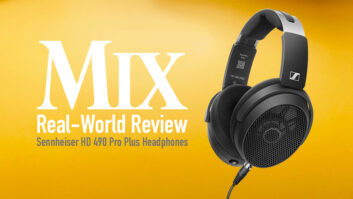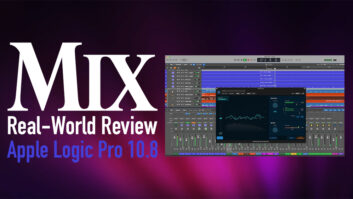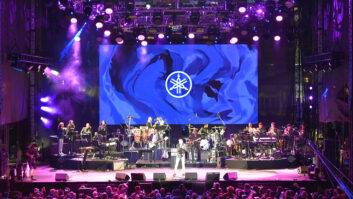Klark Teknik’s initials have long been synonymous with quality EQ, and most engineers in the live sound world are familiar with many of the successful KT equalizer models — from the DN27 to the DN3600 — that have appeared during the past three decades. When KT began shipping its latest product, the DN9340 Helix Digital Equalizer, I had to try it out.
Initially released at last fall’s AES convention, the two-rackspace Helix features 24-bit/48kHz processing. With a dynamic range of 115 dB, it is quieter than a DN360 and sounds clean enough to place in line with any signal chain. The graphic display on the front panel’s left side is similar to that of the old DN3600, and can show either the graphic fader positions or the composite EQ curve. Below the graphic display, a red, highlighted touch strip allows quick selection of filters, and an entire section of sliders can be selected by touching the strip in two places. There are four keys to select the EQ page and Bypass and channel-select buttons. The rest of the front panel is thoughtfully laid out, and the interface is intuitive enough that the user’s manual is only needed for advanced features. There were a few minor things that I didn’t like: The front panel display range is only ±12 dB, and I was not keen on the response of the touch strip. But because the Helix is flash-upgradeable, future enhancements can easily be provided via operating system updates. While I had the Helix, new firmware — Version 2.02 — was published on the KT Website and I easily downloaded it into the review unit.
The Helix graphic display features two pairs of 12-segment input and output LED meters. Above the meters are three rotary encoders — artfully highlighted in blue when active — that allow adjustment of parameters whose names and values are displayed in the 20-character, two-line display. Each “side” of the 2-channel Helix is controlled in four pages, with parameters for each page shown on the interface display. Graphic and Parametric pages need no explanation; a Filters page features notches, shelves and delay, and there is a new Dynamic EQ section, which I’ll discuss more later. In addition to the main-channel bypass, each of the four sections can be bypassed separately, allowing the effect of each layer of EQ to be auditioned individually. The hard-wired main bypass and AC fail-safe mean that the unit is completely out of circuit when bypassed or powered-down, a mission-critical feature for any full-mix processor.
COMPREHENSIVE FEATURES
As one might expect, both channels of the Helix offer 31 graphic EQ filters with 12 dB of cut or boost on standard ISO centers. As in the DN3600, Helix’s graphic EQ section offers two familiar choices of filters: either the overlapping DN 360-type or the DN 27-style filters, which overlap less at low cuts. One benefit of this feature is that it becomes easy to compare the behavior of the different EQ filter types. You can learn a lot about filter-width behavior by just sitting down in a control room and spending a day with the Helix.
Each channel also offers a dozen fully parametric filters. The parametric filters can be displayed one filter curve at a time, with all of the individual curves layered or as the composite of all the curves added together as a single curve. When the composite curve is selected, the display shows the total result of all filters, including those in other sections. This approach gives a whole new meaning to the term “graphic EQ.” As with all digital parametric EQ, there’s a certain amount of quantization. Twenty choices of frequency per octave may seem like a lot until you realize, for example, that between 800 and 900 Hz, there are only three frequency choices. Level settings for each filter are in 0.1dB increments; I would’ve traded a bit more frequency precision for less resolution of depth.
The Helix also provides three general types of filters, with the graphic’s Q being user-selectable. In fact, the four filter pages can have their type of filter behavior selected by section. The Proportional mode provides wide, low-Q filters at smaller cut and boost settings, while gradually narrowing the filter to higher Q at larger amounts of cut and boost. Thus, the Q becomes proportional to the filter’s depth. Only at large cut settings are these filters narrow enough for feedback control. At lower amounts of cut (and boost), adjacent filters overlap and interact. Ever wondered why it sometimes seems like you’re wrestling with the DN360s in a monitor rig? Proportional Q equalization may be the reason.
Constant Q, on the other hand, maintains the same bandwidth at all settings. Because the definition of Q relates to a filter’s width at its 3dB down points relative to maximum gain, this term is often misunderstood and misapplied. In boost, the 3dB down points are the “shoulders” of the filter (3 dB down from the peak), while in cut, they are the edges of the valley (3 dB down from 0 dB). Filters that are truly constant Q go from wider cuts at first to deeper, steeper notches that aren’t symmetrical to the boosts.
KT addresses this quirk of constant Q terminology with what it calls symmetrical Q filters, which is what most manufacturers mean by constant Q. Symmetrical filters are constant Q in boost, while providing identically shaped filters at cut settings. Because users mostly employ cut filters, it’s worth noting how the behavior of each type differs in Cut mode. Symmetrical filters maintain the same width at all cuts, and so are the most “graphic” in their representation of EQ. By offering a choice of Q value and type, the Helix offers a powerful tool for graphic EQ that goes beyond the choice of DN360 or DN27 mode on the DN3600.
DYNAMIC EQ FILTERS
Each channel of the Helix also has two “T-DEQ” filters, dynamic filters that can be used for threshold-dependent equalization. Like normal parametrics, the T-DEQ filters offer center frequency and Q controls, but the cut/boost control is replaced with two pairs of controls: low threshold and low level, plus high threshold and high level. Below the low threshold, the filter provides the amount of boost or cut set with the associated low-level control. Above high threshold, a second opportunity to cut or boost is similarly available. Between the two thresholds, the filter gradually morphs between the two settings. At signal levels outside of the two thresholds, the filter acts like a parametric with a fixed shape. T-DEQ filter activity is indicated by two pairs of five-segment LEDs.
Though this sounds like a complex function, there are many applications that come to mind. One could easily create an automatic loudness contour by building a 100Hz filter that boosted 6 dB at low levels and eased itself out at higher levels. Or, speaker distortion at high levels could be compensated for by placing strategic cuts that kick in at loud volumes.
Finally, each channel has a fourth page where as many as four filters can be configured as up to eighth-order high- or lowpass, high- or low-shelf, and notch filters. And there’s up to a full second of delay, which can also be set for feet or meters with temperature compensation.
Helix has two types of memory: Thirty-two user memories can be stored and recalled from the front panel, while another 32 presets in nonvolatile flash memory can only be programmed directly from an external computer.
OPTIONS AND UPGRADES
The single-rackspace Helix DN9344 slave forgoes front-panel controls, but provides four channels of processing and is priced the same as the DN9340 master. Multiple DN9344 slave systems may be operated from a single master-unit control surface, which allows for some interesting economies. For example, 18 channels of Helix EQ (one master, three slaves) will fit into six rackspaces and costs only 25% more than nine 2-channel DN360 graphic EQs, which would require 27 rackspaces. The added value of 12-band parametrics, dynamic EQ, delay and the simple pleasure of operating all units from a conveniently located master make the Helix very tempting. Midas Heritage and Legend console users can take advantage of the remote-control Auto-Solo function, whereby the Helix channel assigned to a particular output can be automatically called to the master unit when that output is soloed.
Future options for Helix will include an AES I/O expansion card, and Smaart device control, which is available for earlier KT EQ units and processors, is expected soon. When fitted with an optional interface module, Helix will link to KT’s DN6000 RTA to provide auto-EQ functions.
With the growing popularity of self-powered speaker systems, the Helix offers an integrated alternative for much of the processing found in proprietary or third-party speaker processors. It’s easy to imagine that KT’s DN9340 Helix Digital Equalizer will be the foundation of high-profile rigs and installations in the future.
Klark Teknik, 12000 Portland Ave. South, Burnsville, MN 55337; 952/884-4051 or toll-free at 800/392-3497; fax 952/884-0043; www.klarkteknik.com.
Mark Frink is Mix’s sound reinforcement editor.

